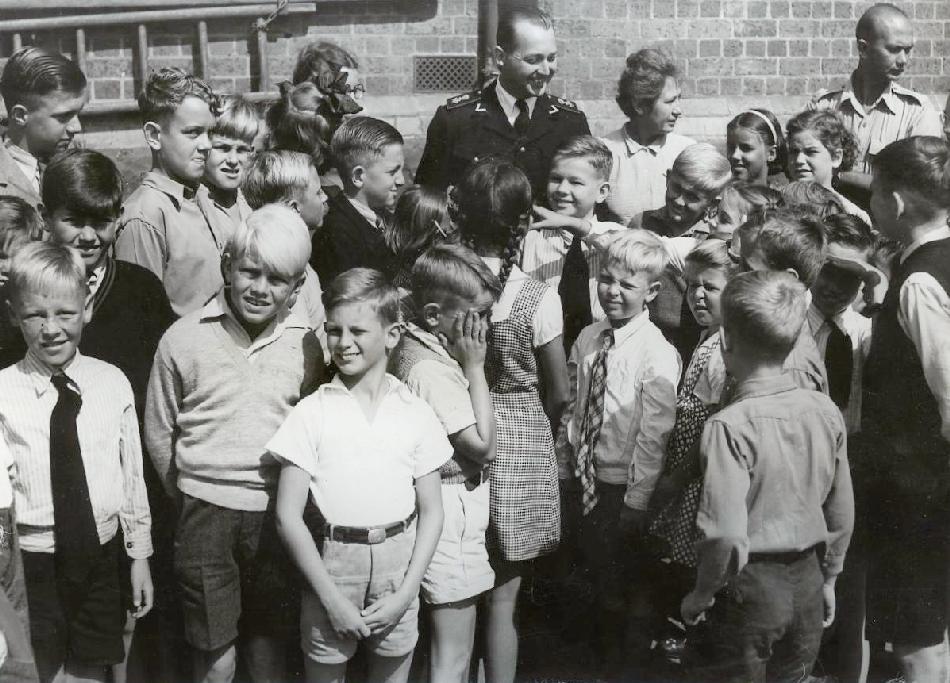
Indonesian History: Dutch Repatriation (1945-64)

Figure 1.--This press photo was maked only 'Dutch evacuees start school' and dated March 13, 1946. We believe that the children were the lucky survivors of the Japanese World War II internment camps (1942-45). Many children did not survive. They seemed to have recovered from the ordeal. Many of the Dutch attemptd to stay in the DEI after the War. Only after the fighting intensified and the Indonesians obtained independence did they return to the the Netherlands in large numbers.
|
|
we have not been able to find a good account of what happened to the Dutch in the Dutch East Indies after the war. According to the DEI Census there were some 240,000 Dutch in the colony before the War. [DEI Census, 1930] We are not sure how many Indos were counted with the Dutch. Or just how Dutch or Indo identity was determined. Some Indos looked like Indoesians and some like Dutch and ever gradiation in between. The Japanese forced the Dutch into fetid internment camps after they conquered the colony (April 1942). The numbers we have seen are about 170,000 internees. We are not sure why there was such a large differene between the two figures. Perhaps it relates to the Indo issue or perhaps the POWs were counted seprately. Some 25,000 Dutch perished in the Japanese camps. The number would have been much higher if the Japanese had not been forced to surrender in August 1945 by the Americans. The conditions in the camps were so horific that the starving, sick internees were beginning to die in increasing numbers. We have not yet found data as to how many Dutch returned to the Netherlands after liberation (September-October 1945). We at first thought that many if not most did. The Americans, Australians, Brits, and French in the various Japanese camps virtually all returned home after liberation. This does not seem to have been the case for the Dutch. This was because for most of the Dutch, home was the DEI. A Dutch reader tells us that his father briefly visited the Netherlands before the War and the climate was so cold and unpleasant that he pledged never to go back again. So he grew up in the DEI. Added to this, the Allies and Germans had done a perty good job of desroying Dutch industries, so the Netherlands was not well positioned to assimilate a large, impoverished expatriate population. As a result, most of the Dutch remained in the DEI until the Dutch granted independece (1949). We do not yet, however, have data to substantiate this. Many of the Dutch colonials had never been to the Netherlands. Many had lived in Indonesia for generations and had comfortable lives there. Most loved the climate. Some chose America or Australia. Most returned to the Netherlands. Some of the Dutch tried to say in independent Indonesia, but most found they were unwanted and that there was no opportunities for them there. Most of those who remained were expeled as a result of the desputes over Papua (1957). Another aspect of the repatrition issue was the Indos--meaning people of mixed Dutch-Indonesian ancestry. This group appears to have amounted to some 300,000 people. They were people between two cultures and in the eyes of many Indonesians were tainte by heir connections with the Dutch. Unlike the Dutch, they did not emigrate to the Neterlands as rapidly as the Dutch. Repatriation is not quite the right term for them, but is the term that is commonly used. One author describes five distinct waves. The first wave took place just after the Pacific War and during the Bersiap/Indendence War period (1945-50). They were the largest wave numbering some 100,000 people and consisted of the Indos held in the Japanese camps and those affected by the disorders and fighting. The second wave was also fairly large (1950-57). They were the civil servants, administrators, and soldiers in the Dutch colonial administration and army and of course their families. Almost all lost their jobs after independence (1949). They were unemployed and without prospects. The other waves were smaller and asociated wih Papua (1957-58) and West Papua. (1962). The final wave was not really a wave, but as steady drip (1957-64). There was no specific event driving this group from Indonesia. They left gradually because, they realized that they were not being accepted by other Indonesians and just could not integrate into Indonesian society. Many missed family and friends and who had already left Indonesia. And their employent and business opportunities were virtually nonexistent. [DSD-UCB] Here their ancestry was not only a factor, but the socialist policies of the Indonesian Government were proving an abject failure. The Netherlands economy on the other hand had not only recovered, but was booming. This ended when the Dutch government ended its repatriation program (1964). A factor here was that Indonesians with no Dutch ancestry were beginnking to seek economic opportunities in the Netherlands.
Sources
DEI Census (1930).
Dower, John W. Dower War Without Mercy (1986).
Dutch Studies Department (DSD-UCB), UC Berkeley. "Amerindo-Repatriation" (2010).
Stueck, Rudi, variou E-mails.
Van der Eng, Pierre. 'Food Supply in Java during War and Decolonisation, 1940-50' MPRA Paper No. 8852 (2008).
CIH

Navigate the Children in History Page:
[Introduction]
[Biographies]
[Chronology]
[Climatology]
[Clothing]
[Disease and Health]
[Economics]
[Geography]
[History]
[Human Nature]
[Law]
[Nationalism]
[Presidents]
[Religion]
[Royalty]
[Science]
[Social Class]
[Bibliographies]
[Contributions]
[FAQs]
[Glossaries]
[Images]
[Links]
[Registration]
[Tools]
[Children in History Home]
Navigate the Boys' Historical Clothing national pages:
[Return to the Main Indonesian independence struggle page]
[Return to the Main Indonesian history page]
[Return to the Main Indonesian page]
[Return to the Main Oceania history page]
[Australia]
[Hawaiian Islands]
[Kiribati]
[Marianas]
[Micronesia]
[Nauru]
[Palau]
[Philippines]
[Pictcarin]
[Samoa]
[Solomans]
[The Netherlands]
Created: 1:24 PM 10/14/2015
Last updated: 1:24 PM 10/14/2015



